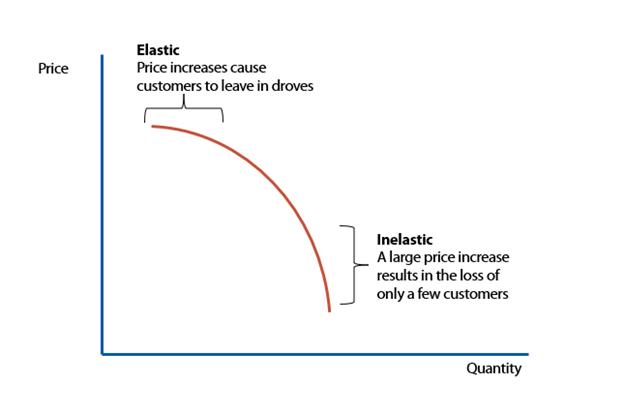Price increases are often the easiest way to increase revenues… right up to the point where the trickle of customers who leave due to your price hikes becomes a torrent.
The big risks that come with over-charging convince many firms to keep prices the same, even when it’s clear that they could charge more.
Still, there is a safe and conservative way for you to investigate if an increase will drive revenue or drive customers away.
It all starts with understanding the elasticity of demand — the willingness of your customers to continue to buy your product or service if you raise prices.
Understanding Elasticity of Demand
To understand the impact of price changes on sales and revenues, you need to have insight into the elasticity of demand for your products or services.
According to Investopedia, “Price elasticity of demand is a measurement of the change in consumption of a product in relation to a change in its price.
Expressed mathematically, it is:
“Price Elasticity of Demand = % Change in Quantity Demanded / % Change in Price”
Products and services with inelastic demand increase revenues when they raise price because they see only a small drop-off in sales as a result of a price increase. Products and services with elastic demand lose revenue when they increase prices as they see their sales volume fall off a cliff.

The Four Questions
If you’re considering a price increase and just starting to get a handle on your elasticity of demand, you can start by asking four, simple questions about your products or services:
- Do you have happy customers? Are they satisfied with your service and would they recommend it to a friend? Some companies can charge more than competitors because they have great products and excellent client service.
- Is your product differentiated? That is, how different is your product or service from your nearest competitors’ offerings? If your product is unique in the marketplace, then you have much more flexibility to raise prices. If it’s one of many offerings in a commoditized field, there may be less opportunity for a price increase.
- Is your product important? Is your product or service mission-critical for your customers, or a nice-to-have? If you have a product that your customers can’t do business without, you’re in a stronger position to raise prices — if the answers to the other questions are also “yes.”
- Is it hard to switch to another provider? Are there significant costs or risks involved for your customers in moving to another vendor? Differentiation, financial costs, and other operational considerations tie into switching difficulty. If your customers need to endure a lot of pain to move to one of your competitors, then you have more latitude for a price increase.
These four questions give you a very basic sense of direction for whether your firm can increase prices. If the answers are all “yeses,” or if you have a “no” or two, or a couple of maybes, these can be countered by a strong yes in any of these categories.
The four questions give you a sense of your elasticity of demand, and whether you have an opportunity to raise prices.
Still, the answers to the four questions are only the first step. On their own, they are not enough to reveal a specific strategy for raising prices, how much to raise, or whether you can make more money by lowering prices to increase sales volume.
Next Steps
To get an understanding of your elasticity of demand, and to arrive at actionable insights, you need to apply market pricing dynamics and price modeling analysis.
- Market Pricing Dynamics. Market pricing dynamics is a qualitative analysis that evaluates data from your wins, losses, sales reps, and competitor research. Market pricing dynamics reveals the role of pricing in buying decisions, and how it affects prospect and client behavior.
- Price Modeling Analysis. Price modeling analysis tells you how customers value specific features in your products and packages. It also shows how much they would be willing to pay for them.
These analyses reveal the elasticity of demand for your products and services, and whether you can increase prices without seeing a drop-off in sales… or if you can maximize revenues by lowering prices.
To learn more about pricing and package optimization, see our additional resources on our Pricing Strategy page
or

